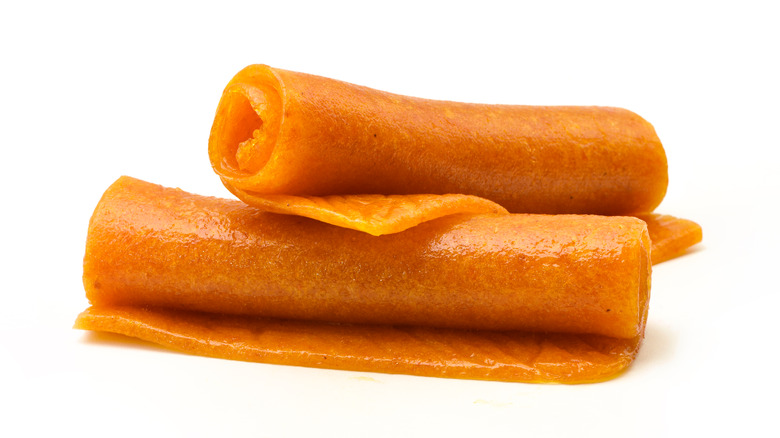It's Easy To Transform Canned Fruit Into Delicious Fruit Leather
Fruit leathers and roll-ups are common items in kids' school lunches, and they're a great snack for grown-ups too. They're super portable for energy on a hike, pack well in a purse for an emergency bite, and go great with a handful of nuts for an afternoon snack. Fruit leathers are also super healthy as they're made out of simply dehydrated, pureed fruit — no preservatives, no funky ingredients. Since the recipe is so simple, it's not hard to make your own dried fruit snacks at home.
There are many recipes for making fruit leathers at home from whole, fresh fruit, but there's an easier way: canned fruit. If you want to try making fruit leathers, but you're pressed for time, you can skip all the cutting, peeling, and cooking and make some yummy fruit snacks with fruit that's already been prepped and heated. As long as you choose cans of produce packed with fruit juice instead of syrup, you'll get the same nutritional values as snacks made with fresh fruit, and you can skip using the stovetop.
Choose a flavor and puree
The reason why canned fruit is faster than fresh fruit for making snacks is that all canned fruit is heated before it's sealed in the can to prevent harmful pathogens. When working with fresh fruit, you have to cook it for the same reasons, as well as to convert some of the sugars to starch, evaporate some of the water, and make the fruit soft enough to puree. If you puree fresh fruit, you'll get something that's more like juice, which will take a lot longer to dry out.
Fruit leather flavors are only limited to whatever you can find for sale at the grocery store, and don't be afraid to mix a couple of different fruits together. If you do any canning with fresh fruit, you can definitely use those jars as well, including applesauce or other pre-canned purees.
Once you choose your flavors, drain the fruit away from the juice it's canned in. If you want, you can save that juice to use in a cocktail or you could freeze it for flavorful ice cubes. When the fruit is drained, puree it in a blender or food processor until it's smooth. Taste your puree at this point, and if you'd like to make it a little bit sweeter you can add a tablespoon of sugar. However, most of the time it will be sweet enough.
Time to dehydrate
When the puree is ready, you can dehydrate it in two different ways: in the oven or with a food dehydrator. If you have a dehydrator, line the shelves with plastic wrap or parchment paper so that the edges fold over the bottom. When the surfaces are ready, spread the puree on each rack or tray so that it's around ¼ to ⅛-inch thick — this is about the width of your pinky finger or half the width of your pinky finger. Once you have all the puree spread out evenly, set the dehydrator to the fruit setting — which is around 120 to 135 degrees Fahrenheit – and let it dry for around four hours before checking on it.
If you're using a conventional oven, set it to the lowest setting or "warm," usually around 170 degrees Fahrenheit. Now, line a sheet pan with plastic wrap, parchment, or a Silpat baking mat and spread the puree about ¼ to ⅛-inch thick. Put the pan in the oven and let it dry for four to eight hours.
Your fruit leathers are done when the fruit sheet is sticky but you can peel it away in a sheet when you test a corner. Once they're ready, cut them into strips and roll them up in plastic wrap, wax paper, or parchment paper and store them in an airtight plastic bag to keep them from absorbing moisture from the air. When you're ready for a snack, unroll a leather or two and enjoy.


